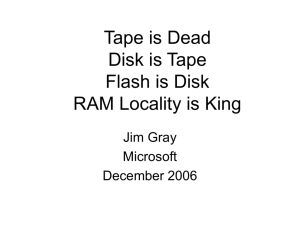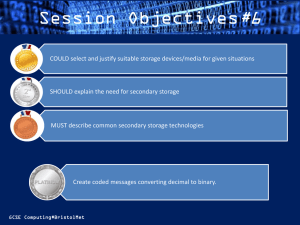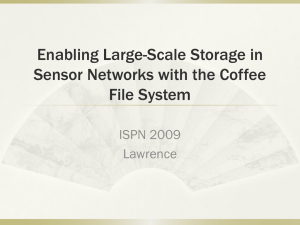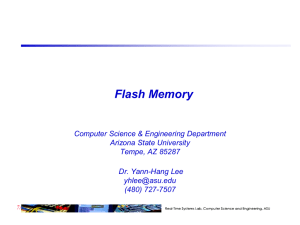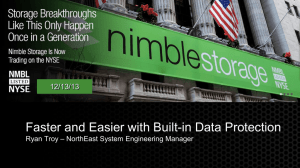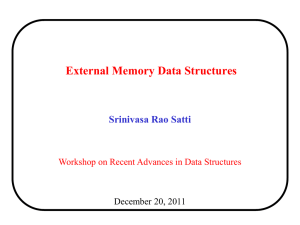Lecture 24
advertisement
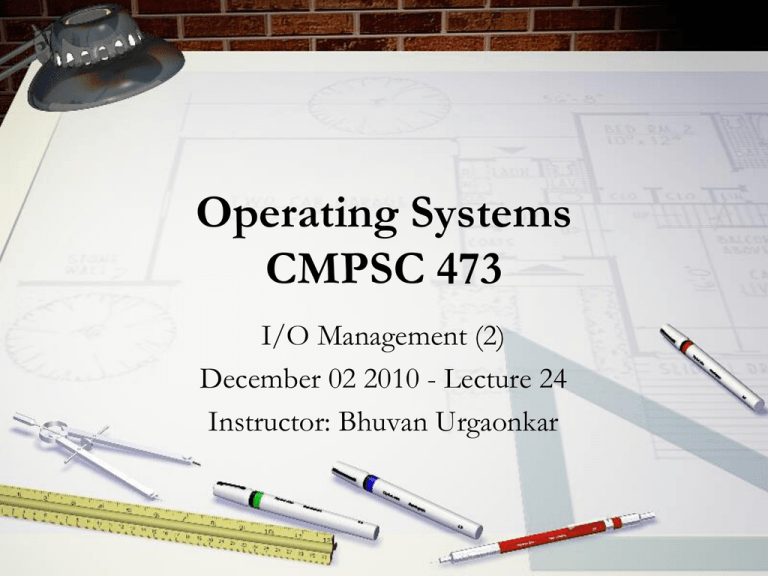
Operating Systems CMPSC 473 I/O Management (2) December 02 2010 - Lecture 24 Instructor: Bhuvan Urgaonkar Moving-head Disk Mechanism Overview of Mass Storage Structure • Magnetic disks provide bulk of secondary storage of modern computers • Drives rotate at 7200 to 15000 times per minute (RPM) – 120 to 240 times per second • Positioning Time (random-access time) – Seek time: time to move disk arm to desired cylinder – Rotational Latency: time for desired sector to rotate under the disk head • Transfer Time: Time to read data • Request service time = Positioning time + Data Transfer Time Overview of Mass Storage Structure • Drive attached to computer via I/O bus – Busses vary, including EIDE, ATA, SATA, USB, Fibre Channel, SCSI – Host controller in computer uses bus to talk to disk controller built into drive or storage array Disk Structure • Disk drives are addressed as large 1-dimensional arrays of logical blocks, where the logical block is the smallest unit of transfer. • The 1-dimensional array of logical blocks is mapped into the sectors of the disk sequentially. – Sector 0 is the first sector of the first track on the outermost cylinder. – Mapping proceeds in order through that track, then the rest of the tracks in that cylinder, and then through the rest of the cylinders from outermost to innermost. Growing Popularity of Flash Disks • “The NAND market has grown faster than any technology in the history of semiconductors, exceeding $11 billion in 2006, only a decade after its introduction ” – Jim Handy, Objective Analysis • Embedded storage: PDAs, mobile phones, digital cameras, digital music players • Desktop storage: MacBook Air, One Laptop Per Child (OLPC), game consoles, Intel’s X25-E Extreme SATA Solid-State Drive • Enterprise scale storage: Texas Memory System’s RamSan-500, Fusion-io’s ioDrive, Symmetrix DMX-4 from EMC 10 • Why Flash is Likely to be Benefits over magnetic hard drives Around – Semi-conductor technology, no mechanical parts – Offers lower and more predictable access latencies • Microseconds (45us Reads / 200us Writes) vs milliseconds for magnetic – Lower power consumption – Higher robustness to vibrations and temperature • Dropping prices – Some projections suggest comparable with magnetic by 2017 – Likely to offer significant cost advantage over other emerging technologies (e.g., PCM) for a decade or more 12 Flash Solid State Drive (SSD) File System Read Sectors Write Sectors Block Interface Controller (FTL) RAM Flash Memory 13 Basics of NAND Flash Memory Data OOB Page Data OOB Page Data OOB Page Page Page Page …… NAND Flash Page Block • • • …… Page …… …… Page Block Block Three operations: read, write, erase Reads and writes are done at the granularity of a page (2KB or 4KB) Erases are done at the granularity of a block – Block: A collection of physically contiguous pages (64 or 128) – Block erase is the slowest operation requiring about 2ms • Writes can only be done on erased pages 14 Out-of-Place Updates Data Update OOB Invalid V LPN=A, LPN=B, V LPN=C, V LPN=A, Free V LPN PPN (PBN, Offset) A B (0, 3) 0) (0, 1) C (0, 2) Flash Mapping Table Block 0 • Over-writes on the same location (page) are expensive • Updates are written to a free page 15 Garbage Collection • Reclaims invalid pages • Typically, called when free space falls below a threshold • Victim block selection – Small # valid pages (reduce copying overhead) – Small # overall erases (wear level) 16 • Flash Translation Layer (FTL) Flash Translation Layer – Emulates a normal block device interface – Hides the presence of erase operation/erase-before-write – Address translation, garbage collection, and wear-leveling • Address Translation – Mapping table present in small RAM within the flash device 17


